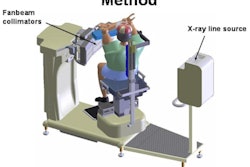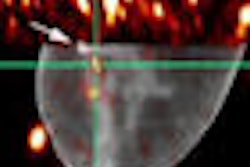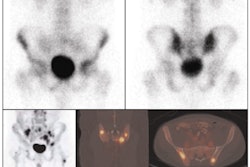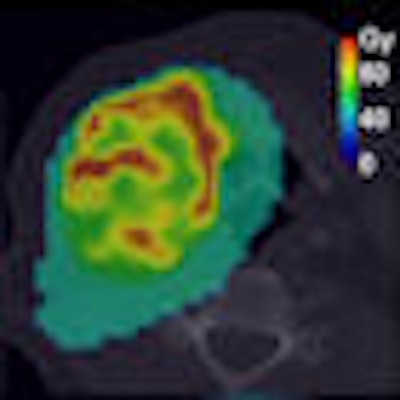
As intensity-modulated radiation therapy (IMRT) becomes more sophisticated, oncologists are investigating new dose-painting methods to determine which areas of tumor target volume should receive additional radiation dose. But a new study indicates that two promising methods to guide dose painting actually produce sharply varied results.
Dose painting enables radiation therapists to deliver more dose to cancerous tissue that is more resistant to radiation, while sending a lower dose to less resistant parts of the target volume. But what's the best way to figure out which cancer cells will be most stubborn during the radiation therapy procedure?
PET is one possibility, according to research presented at the American Association of Physicists in Medicine (AAPM) meeting in Houston last month. In the study, researchers from Slovenia, along with collaborators at the University of Wisconsin, Madison, looked into two PET-based dose-painting techniques and compared their concordance with each other and with an older approach in which radiation dose is uniform across the target volume.
One PET-based technique simply analyzes a tumor's uptake of a radioisotope as measured by standardized uptake values (SUVs), with target volumes that produce higher SUVs indicating the increased levels of cell division common among cancer cells. Once treatment is started, those cancerous cells that remain bright would be considered radiation-resistant, and more radiation could be delivered to those areas.
A more sophisticated method, however, might measure how a PET radiopharmaceutical travels through the body and is taken up by cells over time. One such technique uses a PET radiotracer called fluoro-L-thymidine (FLT). In the AAPM presentation, the researchers, led by Urban Simonic of the Institut Jožef Stefan in Ljubljana, Slovenia, compared an approach to dose painting based on a factor derived from FLT studies (called KFLT) to the SUV approach.
The researchers applied both the SUV and KFLT techniques to the same set of PET/CT images, derived from a population of patients with head and neck, gastrointestinal, and lung carcinoma. The PET/CT studies consisted of 90-minute dynamic scans with 27 frames taken pretreatment and one to two weeks into treatment using the FLT radiopharmaceutical. After dosimetric calculations, the two dose-painting techniques were compared with each other, as well as to a technique using an escalating uniform radiation dose. All three techniques were compared to their variance from the dose treatment plan.
Dose painting based on the SUV approach generated a dosage that was about 10% different in 25% of the target volume compared with the KFLT prescription. The SUV method was still much improved over the uniform dose escalation, where more than 75% of the target area received greater than 10% dose difference from the treatment plan.
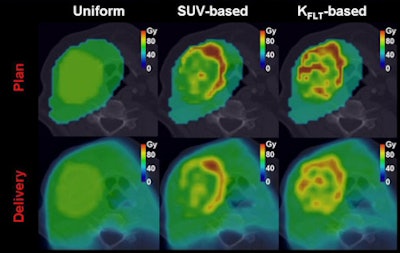 |
| Top row shows treatment dose plan based on uniform dosing and SUV-based and KFLT-based dose painting. Bottom row shows dose delivery. Image provided by Urban Simonic, Institut Jožef Stefan, Ljubljana, Slovenia, and the University of Wisconsin, Madison. |
In head and neck radiotherapy, uniform dose differences between the treatment plan and the dose are always considerable, Simonic said, and either dose-painting technique could help reduce that disparity. He added that although the dose escalation differences between the two are minor, their different results on regions of radio-resistance would lead to significantly different treatment approaches.
While the SUV method shows cells in the process of division, the KFLT method may be more precise because it shows how FLT travels in the body and is taken up by cells over time. But "SUV-based dosing is not useless," Simonic said. "It is a better approximation to KFLT-based dose painting than uniform dose delivery."
He advocated additional study, particularly of kinetic mechanisms at the molecular level, to determine which method is superior overall. "Doing kinetic analysis makes sense because SUV-based dose painting and KFLT-based dose painting lead to significantly different treatments," he said.
By Kathlyn Stone
AuntMinnie.com contributing writer
August 27, 2008
Related Reading
On-board imaging adds accuracy to IMRT for prostate, June 25, 2008
FDG-PET/CT aids in radiation therapy planning, March 5, 2008
Intensity-modulated radiation therapy is inconsistently delivered, March 4, 2008
Copyright © 2008 AuntMinnie.com




